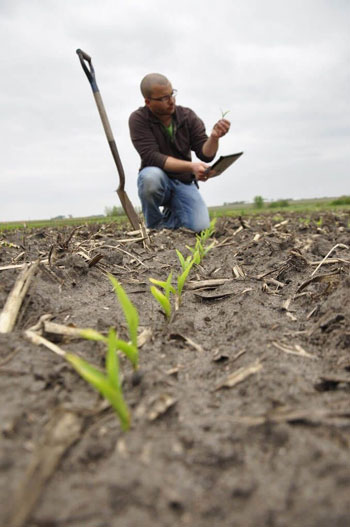The 2021 Virtual Crop Scout School is now available and is free to the general public. The scout school consists of 22 webinars from crop protection specialists at eleven Midwest Universities and is offered through the Crop Protection Network (CPN).
Crop scouts, farmers, and other users can pick and choose from a variety of diverse subjects to help them become more knowledgeable on crop scouting. Topics are split into digestible bits so crop scouts can interact with subject matter in a way that best suits their time and interest.
Two K-State specialists contributed webinars related to their respective specialty. These webinars are listed below with a short summary about their topic.
Sarah Lancaster, Weed Science Extension Specialist: Grass seedlings appear similar to one another while standing up, but get closer to them and you’ll be able to see that there are many different species common in crop and forage fields. In this webinar, she explains how to differentiate between common grasses utilizing characteristics such as habitat and growth habit, as well as plant parts such as auricles, collars and ligules. Grass flowers can also be used to identify weed species.
Rodrigo Onofre, Plant Pathology Postdoctoral Fellow: Identifying corn diseases in the field can be difficult and some diseases require sending samples to a lab for confirmation. In this webinar, he will share the information crop scouts should gather before heading to the field, as well as resources that help scouts gather information before arriving at the field. He will also explain common signs and symptoms of diseases, where they show up on a plant and what conditions favor disease development. Many disorders and diseases are easily confused for one another.
Crop scouting in an important part of integrated pest management (IPM) that can help farmers obtain higher yields and increased profit per acre. Scouting gives farmers and agronomists a "heads-up" about what is happening in the field, allowing preemptive action and appropriate management decisions to be applied. The field scout gathers information on the crop condition of a field, which can help in discerning which of the various management tools to use (Figure 1).

Figure 1. Scouting crop fields on a regular basis can help to determine emerging crop problems and helps to inform management decisions. Image by Brandon Kleinke.
Interested individuals can access the crop scout school at: https://cropprotectionnetwork.org/virtual-crop-scout-school
Additional resources and CEU credits
Earlier this year, the CPN released a free web book on crop scouting – Crop Scouting Basics for Corn and Soybean. This resource is available for online and is a valuable complement to the 2021 Virtual Crop Scout School.
After reading CPN publications and watching virtual webinars, like the web book and Virtual Crop Scouting School, Certified Crop Advisors can complete the corresponding quizzes to earn continuing education credits (CEUs). More information on this process is found at: https://ceu.cropprotectionnetwork.org/
CPN has partnered with Universities all over the Midwest to make these webinars a reality. This work is/was supported by the USDA National Institute of Food and Agriculture, Crop Protection and Pest Management Program through the North Central IPM Center (2018-70006-28883).
CPN is a multi-state and international partnership of university and provincial Extension specialists, and public and private professionals that provides unbiased, research-based information. CPN’s goal is to communicate relevant information to farmers and agricultural personnel to help with decisions related to protecting field crops
For more information, please contact cropprotectionnetwork@gmail.com
Tags: virtual crop scouting